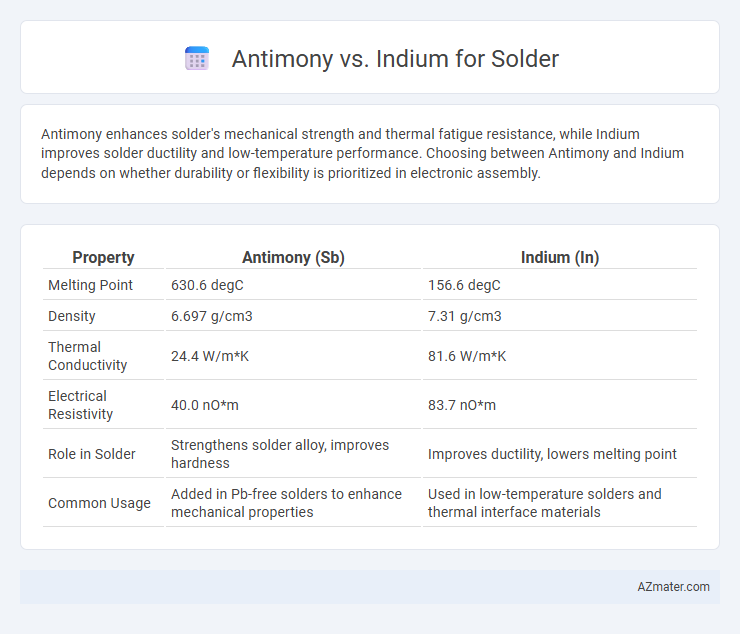Antimony enhances solder's mechanical strength and thermal fatigue resistance, while Indium improves solder ductility and low-temperature performance. Choosing between Antimony and Indium depends on whether durability or flexibility is prioritized in electronic assembly.
Table of Comparison
| Property | Antimony (Sb) | Indium (In) |
|---|---|---|
| Melting Point | 630.6 degC | 156.6 degC |
| Density | 6.697 g/cm3 | 7.31 g/cm3 |
| Thermal Conductivity | 24.4 W/m*K | 81.6 W/m*K |
| Electrical Resistivity | 40.0 nO*m | 83.7 nO*m |
| Role in Solder | Strengthens solder alloy, improves hardness | Improves ductility, lowers melting point |
| Common Usage | Added in Pb-free solders to enhance mechanical properties | Used in low-temperature solders and thermal interface materials |
Overview of Antimony and Indium as Solder Materials
Antimony enhances solder alloys by improving mechanical strength, thermal fatigue resistance, and creep resistance, making it suitable for high-reliability electronic joints. Indium offers excellent wettability, ductility, and low melting points, which are ideal for sensitive components requiring flexible, low-temperature soldering processes. Both elements play critical roles in specialized solder applications, with antimony commonly used in lead-based and lead-free alloys, while indium is preferred in advanced electronics and cryogenic environments.
Physical and Chemical Properties Comparison
Antimony exhibits higher melting point (630.6degC) and greater hardness compared to Indium, which melts at 156.6degC with low hardness, making Antimony more suitable for high-temperature and mechanically robust solder applications. Chemically, Antimony is more stable and less reactive, whereas Indium's softness and ductility provide excellent wetting properties and thermal conductivity, enhancing solder joint flexibility and heat transfer. The contrasting physical durability of Antimony and Indium's chemical affinity with metals influences their complementary roles in solder alloys for electronics manufacturing.
Melting Points and Thermal Characteristics
Antimony has a melting point of 630.6degC and is often used to improve the mechanical strength and thermal stability of solder alloys, enhancing heat resistance during soldering processes. Indium, with a much lower melting point of 156.6degC, offers excellent thermal conductivity and ductility, making it ideal for low-temperature solder applications requiring flexibility. The choice between antimony and indium in solder depends heavily on the thermal requirements and operating temperatures of the electronics assembly.
Electrical Conductivity Differences
Antimony and indium differ significantly in electrical conductivity, impacting their effectiveness in solder applications. Indium exhibits high electrical conductivity around 1.2 x 10^7 S/m, making it ideal for low-resistance electrical joints. In contrast, antimony shows much lower conductivity approximately 1.6 x 10^6 S/m, which may limit its use where high electrical performance is critical.
Strength and Mechanical Reliability
Antimony enhances solder strength by increasing tensile and shear resistance, making it ideal for high-stress electronic joints. Indium improves mechanical reliability through superior ductility and thermal fatigue resistance, supporting flexible and vibration-prone applications. The choice depends on whether higher mechanical strength (antimony) or enhanced thermal cycling performance and flexibility (indium) are prioritized in solder formulations.
Corrosion and Oxidation Resistance
Antimony improves solder corrosion resistance by forming stable intermetallic compounds that inhibit degradation in harsh environments. Indium offers superior oxidation resistance due to its ability to form a protective oxide layer, preventing further surface deterioration. Choosing between antimony and indium depends on the specific application requirements for long-term reliability and environmental exposure.
Cost and Availability in the Market
Antimony is generally more affordable and widely available than indium, making it a cost-effective choice for soldering applications. Indium, being rarer and more expensive, is less commonly used despite its superior thermal and electrical conductivity. Market fluctuations and supply chain constraints also impact indium's price and availability more significantly than antimony.
Environmental and Health Considerations
Antimony in solder poses greater environmental and health risks due to its toxicity and potential to cause respiratory and skin issues upon exposure, while indium is generally considered less hazardous but may still pose concerns related to inhalation of dust or fumes during soldering. Indium offers better recyclability and lower ecological impact compared to antimony, which is associated with bioaccumulation and contamination in aquatic ecosystems. Choosing indium-based solder can reduce occupational health risks and environmental pollution, supporting compliance with stricter regulations such as RoHS and REACH.
Typical Applications and Industry Use Cases
Antimony enhances the mechanical strength and thermal stability of solder alloys, making it ideal for high-temperature electronic components and automotive industry applications where durability is critical. Indium provides superior wettability and electrical conductivity, commonly used in precision electronics such as semiconductor devices, aerospace circuitry, and cryogenic applications. Both elements optimize solder performance but cater to distinct sectors: antimony for robust industrial and automotive use, indium for advanced electronics requiring fine electrical and thermal management.
Choosing the Right Solder: Antimony or Indium?
Antimony and indium both serve unique purposes in solder alloys, with antimony enhancing mechanical strength and wear resistance while indium offers superior thermal and electrical conductivity. Choosing the right solder depends on the application requirements: antimony-infused solder is ideal for high-stress environments needing durability, whereas indium-based solder excels in low melting point and flexible joints essential for sensitive electronics. Consider factors such as operating temperature, mechanical stress, and electrical performance to determine whether antimony or indium solder best suits your specific project needs.

Infographic: Antimony vs Indium for Solder
 azmater.com
azmater.com